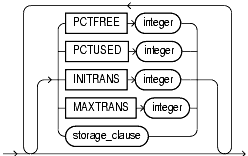| Oracle9i SQL Reference Release 2 (9.2) Part Number A96540-02 |
|
|
View PDF |
| Oracle9i SQL Reference Release 2 (9.2) Part Number A96540-02 |
|
|
View PDF |
Use the ALTER CLUSTER statement to redefine storage and parallelism characteristics of a cluster.
|
Note: You cannot use this statement to change the number or the name of columns in the cluster key, and you cannot change the tablespace in which the cluster is stored. |
See Also:
|
The cluster must be in your own schema or you must have the ALTER ANY CLUSTER system privilege.
alter_cluster::=





Specify the schema containing the cluster. If you omit schema, Oracle assumes the cluster is in your own schema.
Specify the name of the cluster to be altered.
Use this clause to change the values of the PCTUSED, PCTFREE, INITRANS, and MAXTRANS parameters of the cluster.
Use the STORAGE clause to change the storage characteristics of the cluster.
You cannot change the values of the storage parameters INITIAL and MINEXTENTS for a cluster.
See Also:
|
Use the SIZE clause to specify the number of cluster keys that will be stored in data blocks allocated to the cluster.
You can change the SIZE parameter only for an indexed cluster, not for a hash cluster.
| See Also:
CREATE CLUSTER for a description of the |
Specify the allocate_extent_clause to explicitly allocate a new extent for the cluster.
When you explicitly allocate an extent with this clause, Oracle does not evaluate the cluster's storage parameters and determine a new size for the next extent to be allocated (as it does when you create a table). Therefore, specify SIZE if you do not want Oracle to use a default value.
You can allocate a new extent only for an indexed cluster, not for a hash cluster.
| See Also:
|
Use the deallocate_unused_clause to explicitly deallocate unused space at the end of the cluster and make the freed space available for other segments.
| See Also:
|
Specify CACHE if you want the blocks retrieved for this cluster to be placed at the most recently used end of the least recently used (LRU) list in the buffer cache when a full table scan is performed. This clause is useful for small lookup tables.
Specify NOCACHE if you want the blocks retrieved for this cluster to be placed at the least recently used end of the LRU list in the buffer cache when a full table scan is performed. This is the default behavior.
Specify the parallel_clause to change the default degree of parallelism for queries and DML on the cluster.
If the tables in cluster contain any columns of LOB or user-defined object type, this statement as well as subsequent INSERT, UPDATE, or DELETE operations on cluster are executed serially without notification.
Specify NOPARALLEL for serial execution. This is the default.
Specify PARALLEL if you want Oracle to select a degree of parallelism equal to the number of CPUs available on all participating instances times the value of the PARALLEL_THREADS_PER_CPU initialization parameter.
Specification of integer indicates the degree of parallelism, which is the number of parallel threads used in the parallel operation. Each parallel thread may use one or two parallel execution servers. Normally Oracle calculates the optimum degree of parallelism, so it is not necessary for you to specify integer.
The following examples modify the clusters that were created in the "Examples" section of CREATE CLUSTER on .
The next statement alters the personnel cluster:
ALTER CLUSTER personnel SIZE 1024 CACHE;
Oracle allocates 1024 bytes for each cluster key value and turns on the cache attribute. Assuming a data block size of 2 kilobytes, future data blocks within this cluster contain 2 cluster keys in each data block, or 2 kilobytes divided by 1024 bytes.
The following statement deallocates unused space from the language cluster, keeping 30 kilobytes of unused space for future use:
ALTER CLUSTER language DEALLOCATE UNUSED KEEP 30 K;